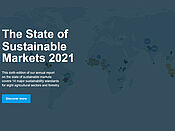The State of Sustainable Markets 2021
Consumer preferences for healthier and more sustainably grown foods underpin the continued popularity of certified commodities.
More farm and forestry land than ever is used to grow sustainable commodities, though the pace of expansion is slowing. The growing popularity of certified goods helps ensure the production and trade of more agricultural commodities that promote environmental quality, social equity and economic prosperity.
The State of Sustainable Markets 2021 is the sixth edition of the annual report on the status of sustainable markets, which the International Trade Center (ITC) has been publishing jointly with the Research Institute of Organic Agriculture FiBL and the International Institute for Sustainable Development (IISD). It covers 14 major standards for eight agricultural sectors and forestry. For the first time, the report is presented as an e-publication.
"Consumer choices to support small farmers and values-based, sustainable trade are transforming lives," said ITC Executive Director Pamela Coke-Hamilton.
These standards can help tackle challenges ranging from labour issues and loss of biodiversity in the banana and sugarcane markets to deforestation, soil erosion and the use of agro-chemicals in the tea sector. The more than 400 such standards across the globe represent an opportunity along international supply chains to meet resource shortfalls.
Sustainability standards are expanding as more consumers choose more nutritious, ethically grown products. Organic was the biggest sustainability standard in terms of area and product variety, covering 72.1 million hectares or 1.5% of farmland worldwide. The Better Cotton Initiative (BCI), Rainforest Alliance, the Round Table on Sustainable Palm Oil, and GlobalG.A.P. for the first time covered more than 4 million hectares in 2018 ,2018, with BCI almost reaching 5 million hectares in 2019, after growing another 18.3%.
Certified area for agricultural commodities expanded by at least a third in 2015–2019, peaking in 2016-2017 (+17.9%) and slowing down in consecutive years (2017-2018: +7.9%; 2018-2019: +1.8%). The highest four-year growth (2015-2019) was reported for sugarcane (+123.7%), followed by cotton (+99.9%), and cocoa (+53.2%). The highest one-year growth (2018-2019) was reported for sugarcane (+14.8%), followed by cotton (+11.2%) and tea (+8.1%).
Certified coffee, cocoa, and soybeans lost ground in 2018–2019.The area used to cultivate sustainable coffee shrank by 18.5% and cocoa by 12.7%. The cultivated land for certified soybeans declined by 6%.
Some single-sector standards predominate
Standards that certify just one commodity, such as Bonsucro, the Better Cotton Initiative and the Roundtable on Sustainable Palm Oil, dominate in some sectors, the report finds.
Cotton still covers the most certified land area – with more than 6.5 million hectares (16.8% of the global cotton area) – and 12.6% of that certified by the Better Cotton Initiative. Oil palm overtook cocoa as the second-biggest sustainable crop, with 3.1 million hectares certified, or 10.9% of the global oil palm area. The Roundtable on Sustainable Palm Oil certifies almost all of this (10.8%).
Some 2.8 million hectares, or 22.7% of the global cocoa area, are certified, mainly by UTZ (20.8%). Sugarcane has moved into fourth place, edging ahead of coffee. More than 2.5 million hectares, or 9.5%, of the global sugarcane area is certified, with 5.8% by Bonsucro.
Supply often outpaces demand, so some standard-compliant products are not labeled or sold as such. Europe and North America drive demand and the pace of growth in other regions is not keeping up.
The report is funded by the Swiss State Secretariat for Economic Affairs. Voluntary standards are usually third party-assessed norms and requirements linked to environmental, social, ethical and food safety issues.
Contact
- Claudia Meier, FiBL Switzerland
- Bernhard Schlatter, FiBL Switzerland
- Helga Willer, FiBL Switzerland
Link
- digital.intracen.org: E-publication "The State of Sustainable Markets 2021"
- intracen.org: PDF version of "The State of Sustainable Markets 2021"

 tap and then scroll down to the Add to Home Screen command.
tap and then scroll down to the Add to Home Screen command.